
|
Sale 55
Ancient and World Coins
| Lot |
Photo |
Description |
Realized |
Lot 79 |
 |
Ancient Judaea. The Jewish War, 66-70 CE. AR Shekel (13.54 g) dated year 2 (67/8 CE). Temple vessel with rim decorated with nine pearls; above, date. Reverse: Stem with three pomegranate fruits. Mesh 151; AJC II, 260, 8; H. 659. Large flan. A beautiful shekel. Extremely Fine.
Estimated Value $1,500 - 2,000.
View details and enlarged photos
| Realized
$3,910 |
Lot 80 |
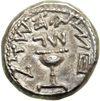 |
Ancient Judaea. The Jewish War, 66-70 CE. AR Half Shekel (6.96 g) dated year 3 (68/9 CE). Temple vessel with pearled rim; above, date. Reverse: Stem with three pomegranate fruits. Mesh1 155; H. 663. About Extremely Fine.
Actually much rarer than the full shekel of the same date, this denomination paid the yearly Temple tax.
Estimated Value $1,300 - 1,500.
View details and enlarged photos
| Realized
$4,025 |
Lot 81 |
 |
Herod Archelaus, 4 BCE-6 CE. AE 2 Prutot (18.5 mm). Double cornucopiae. Reverse: Galley to left with oars. Mesh1 59; H. 503. Galley particularly well defined. Very Fine.
Estimated Value $250 - 350.
View details and enlarged photos
| Realized
$312 |
Lot 82 |
 |
Herod Agrippa II, 56-95 CE. AE 22 minted under Domitian, dated year 24 (83/84 CE). Laureate head right of Domitian. Reverse: Inscription within wreath. AJC II, pl. 13, 23; H. 603. Very Fine.
Estimated Value $250 - 325.
View details and enlarged photos
| Realized
$144 |
Lot 83 |
 |
Titus, AD 79-81. AE 25.5 minted under Domitian, dated year 26 (86/7 CE) under Herod Agrippa II. Laureate head right honoring Titus, brother of Domitian. Reverse: Nike advancing right. AJC plate 14, 32a; H. 612. About Very Fine.
Estimated Value $200 - 250.
View details and enlarged photos
| Realized
$156 |
Lot 84 |
 |
Titus, 79-81 CE. AE 24 minted at Caesarea. Laureate head right of Titus. Reverse: Mourning Judaea seated left below trophy, her hands tied behind her back, shield to right of trophy. AJC II, p. 289, 5; H. 745. Fine to Very Fine.
Estimated Value $300 - 400.
View details and enlarged photos
| Unsold |
Lot 85 |
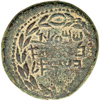 |
Large Bronze (30mm, 24.3g) dated Year One (132/3 C.E.). Hebrew inscription within wreath: Simon Prince of Israel. Reverse: Amphora with two handles surrounded by: Year One of the Redemption of Israel. Nicely struck considering the difficulty of overstriking these large, heavy coins. Attractive green and tan earthenware patina. H-677. Mild. 8 (only 8 cited, this being the finest). Very Fine.
Estimated Value $5,000 - 7,000.
Stanley Yulish Collection.
View details and enlarged photos
| Realized
$12,650 |
Lot 86 |
 |
Judaea. The Bar Kokhba War, 132-135 CE. Large Bronze (32. 5 mm.; 21.19 g), dated Year Two, struck 133/134 CE. This coin is essentially as struck, and so we consider the piece a Superb Extremely Fine at the least. Filleted olive wreath, Palaeo-Hebrew inscription in two lines within ("Shim'on"). Reverse: Twin-handled, fluted amphora; Palaeo-Hebrew inscription around ("Year two of the freedom of Israel"). Mildenberg 19 (11 examples cited); Hendin 705; Mesh. AJC II, p. 270, 39. Exceptionally even strike, with the elegant reverse design. Smooth, blackish dark green patina, with occasional lighter dusky coloring. An extraordinary coin in all aspects - strike, flan, metal, style, and preservation. Without a doubt, the finest of its type. Very rare. NGC graded Extremely Fine.
Leo Mildernberg, who wrote the important corpus analyzing the Bar Kokhba coin series, considered the reverse die of the large bronze series, bearing the fluted amphora (seen on the above coin), as the finest and most beautiful design "in the entire Bar Kokhba coinage."
Estimated Value $30,000 - 40,000.
Illustrated in Money of the World, coin 25. Ex Millennia Sale, lot 55.
View details and enlarged photos
| Realized
$83,375 |
Lot 87 |
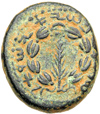 |
The Bar Kokhba War, 132-135 CE. Medium Bronze (22 mm) dated Year One (132/133 CE). Upright palm branch within laurel wreath. Reverse: Chelys-lyre with five strings. Mild 20 [ 7 examples cited]; Mesh 233; H. 680. Rare in such choice condition. Extremely Fine.
Estimated Value $1,250 - 1,500.
View details and enlarged photos
| Realized
$2,530 |
Lot 88 |
 |
Marcus Aurelius, AD 161-180. AE 26.5 minted at Aelia Capitolina (Jerusalem). Confronted laureate busts of Marcus Aurelius and Commodus. Reverse: Laureate and draped bust right of Sarapis wearing modius. Meshorer (Aelia Capitolina) 57; Ros. --. Roughness covered with light green coloring. Extremely Fine.
The coinage of Jerusalem extended from the Persian Period through the third century C.E. The cult of Sarapis, having originated in Egypt, was quite important in Jerusalem, where a temple was built in his honor as early as during the reign of Trajan.
Estimated Value $300 - 400.
View details and enlarged photos
| Realized
$368 |
Lot 89 |
 |
Caracalla, AD 198-217. Billon Tetradrachm (14.77 g) minted at Neapolis, AD 215-217. Laureate head right of Caracalla. Reverse: Eagle standing with spread wings, head left; between legs, altar. Cf. Prieur 1701; Dura 19 (no visible flame above altar). Rare. Choice Very Fine.
Estimated Value $500 - 700.
View details and enlarged photos
| Realized
$299 |
Lot 90 |
 |
Nabataea. Obodas II, 21/20 BCE. AR Drachm (4.27 g) minted 21/20 BCE. Jugate heads right of Obodas II and his queen. Reverse: Diademed head right of Obodas III. Meshorer 29-30. Very rare. Dark "hoard" patina. Nearly Extremely Fine.
Estimated Value $1,500 - 1,750.
View details and enlarged photos
| Unsold |
Lot 91 |
 |
Parthian Kingdom. Mithradates I, c. 171-138 BC. AR Tetradrachm (15.38 g), Seleucia-on-the-Tigris mint. Diademed and draped bearded bust right; reel and spool border around. Reverse: Naked Herakles standing left, holding club and lion's skin; name and royal titles flanking; A-X-P monogram in exergue. Sellwood 13.2; Shore 35. Nicely centered and boldly struck up. A little trifling edge porosity on reverse, some light roughness on the highest points, otherwise metal of unusually high quality for the tetradrachms. Toned devices on lighter fields, with considerable mint luster. Powerful, realistic portrait -- splendid Hellenistic art. Rare, especially in this quality. NGC graded Uncirculated.
This tetradrachm is the first of this denomination struck by the Parthians. Minting was initiated shortly after the Parthians had wrested possession of Mesopotamia away from the Seleucids. As with most of the subsequent tetradrachms, coining took place at the Seleucia-on-the-Tigris mint. The choice quality Hellenistic-style portraits displayed on most of Mithradates' coins would indicate that the trained and talented die-cutters employed by the Seleucids were retained initially. By the end of his reign, the "Greek-ness" of his coins was waning. With the advent of Orodes I's reign, around 90 BC, the coins are wholly "oriental" in technique and style.
Estimated Value $8,000 - 9,000.
Ex Millennia Sale, lot 89.
View details and enlarged photos
| Realized
$11,213 |
Lot 92 |
 |
Parthian Kingdom. Mithradates II, c. 123-91 BC. AR Tetradrachm (15.68 g), Seleucia-on-the-Tigris mint, struck c. 119-109 BC. Diademed, bearded bust left, wearing embellished jacket, with torque at neck. Reverse: Arsakes I, in ethnic garb, seated right on omphalos and holding up bow, all within square formed by legend; A-P-T monogram behind, upright palm to right of legend. Sellwood 24.5; Shore 68; Nicely centered and well struck up on spacious flan. NGC graded About Uncirculated.
The Parthians were the arch (or should we say archer?) enemies of Rome for several centuries. While the silver drachms are most often seen, tetradrachms and bronzes were also issued; there are no gold coins known of this kingdom, encompassing modern Iran and surrounding territories. Many different city-mints were employed, along with traveling military and court mints. Early silver tetradrachms were all very rare and generally in circulated condition until a sizable hoard was unearthed about 15 years ago. Today, this group has been dispersed throughout the world, and occurrences in the modern marketplace are seldom for these glorious, quasi-medallion, Hellenistic portrait coins.
Estimated Value $2,500 - 3,000.
Ex Millennia Sale, lot 60.
View details and enlarged photos
| Unsold |
Lot 93 |
 |
Parthian Kingdom. Mithradates II, c. 123-88 BC. AR Tetradrachm (15.72 g) minted at Seleucia. Diademed and bearded bust left of Mithradates II. Reverse: Archer seated right on omphalos; in exergue, monogram. Sellwood 24v (this monogram not listed). Slightly double-struck. Minted in high relief and nicely centered on a large flan;. Extremely Fine.
Estimated Value $2,500 - 3,000.
View details and enlarged photos
| Unsold |
Lot 94 |
 |
Kingdom of Persis. Bagadates I, c. late 3rd or early 2nd century BC. AR Tetradrachm (15.62 g). Head right, with short beard and mustache, with large earring, and wearing satrapal cap (kyrbasia) with flaps tied up. Reverse: Fire temple of Ahura-Mazda with Bagadates on the left and standard to the right; Aramaic legend around. Alram 515; BMC p. 196, 2; Sear GC 6186. Overstruck on uncertain coin. Superb high-relief portrait; lightly toned. Very rare. Among the finest known examples. NGC graded About Uncirculated.
Persis was located in what is now southwestern Iran. 'Persian' peoples settled the area as early as the 8th century BC, in an area that flourished earlier under the powerful Kings of Elam. As a region it comprised the sandy coasts of the Persian Gulf, with its date palms, plus the fertile upland and mountain valleys, along with parts of the mountainous central plateau. Persis rose to importance as the homeland of the Achaemenid Persians at the beginning of their empire. Darius I was especially proud of owning this territory.
The Achaemenid Empire collapsed under onslaughts by Alexander the Great. After his death, rule of Iran passed into the hands of the Seleucid Kings of Syria. However, Persis remained in the hearts and minds of the Persians as their ethnic and religious homeland -- as the source and wellspring of their "Persian-ness." Arsaces I, around 238 BC, initiated a successful rebellion, broke from Seleucid control, and became the first king of the new Parthian dynasty. Persis and a number of other kingdoms followed suit, yet remained independent. The kingdom of Persis never became a part of the empire of the Arsacids, although her kings recognized Parthia as their suzerain -- when they had to of course.
In its heyday, the authority of the Persis kings extended over the shores of the northern Persian Gulf, and the opposite coasts along Arabia. Persis endured as kingdom for four centuries; the wealth of land and sea trade from the further Orient providing a stable fiscal foundation. Again, as the religious center for the Persian's Zoroastrianism, pilgrims and royal privileges added further to the country's wealth.
Estimated Value $18,000 - 20,000.
Illustrated in Money of the World, coin 27. Ex Millennia Sale, lot 61.
View details and enlarged photos
| Realized
$48,300 |
Lot 95 |
 |
Three Silver Coins of the East. Parthia, AR drachm of Vonones II; Sasania, AR drachm of Peroz; plus an AR siglos of the Persians in Lydian Kingdom (3 deep test marks on reverse). Condition averages VF. Lot of 3 coins. Lot of 3 coins.
Estimated Value $200 - 250.
View details and enlarged photos
| Realized
$265 |
Lot 96 |
 |
Bactria. Agathokles, c. 185-170 BC. AR Tetradrachm (16.94 g), Merv mint(?). Diademed and draped bust of Agathokles right. Reverse: Zeus standing, facing, scepter in left hand and holding in right hand a figure of triple-faced Hekate, who holds two torches; BAΣIΛEΩΣ AΓAΘOKΛEOY, monogram at lower left. Bopear. Série 1D; SNG ANS 230; MIG type 137a; MACW 1677; Rahman 148-149. Splendid sculptural high relief portrait, finely struck on nearly round flan of choice metal. The obverse a superb rendering of an assertive man with an almost ironic air. NGC graded Uncirculated.
Estimated Value $3,000 - 3,500.
Ex Millennia Sale, Lot 65.
View details and enlarged photos
| Realized
$8,625 |
Lot 97 |
 |
Bactria. Antimachos I, Theos, c. 174-165 BC. AR Tetradrachm (16.93 g), Pushkalavati mint(?). Attic standard. Diademed and draped bust of Antimachos right, wearing kausia. Reverse: Poseidon standing, facing, holding long trident and palm with long ribbon, the filleted ends of his diadem draped about his shoulders; BAΣIΛEΩΣ ΘEOY ANTIMAΧOY, monogram at lower right. Bopear. Sêrie 1A, 1-2; SNG ANS 274; MIG 124b; Rahman 173-174. Sculptural high relief portrait, beautifully struck on a generous flan. The obverse a splendid characterization of a somewhat heavy-featured, pragmatic man of advanced years. NGC graded Uncirculated.
The portraits of this enigmatic Bactrian ruler have often been considered by scholars and connoisseurs alike as being among the greatest numismatic portraits of antiquity. The bold yet simple forms of his accoutrements serve both as a compliment, as well as a counterpoint to the psychological complexities of his visage. His best portraits come in three variants -- two with smiles, one sometimes genial, the second more ironic. Less common is the one seen above, where the mood is subdued and clearly introspective.
Antimachos was unknown to modern historians until his coins were discovered in 1822. It is well known that the topographical extremes of the country presented the Graeco-Bactrian rulers with considerable obstacles to maintaining a unified, single-monarch ruled domain. Based on the evidence of his coinage, it seems that Antimachos held sway over the rich and populous plateau region of the north (modern day Afghanistan). In the south, below the Hindu Kush, the territories were maintained by either an associate, or subordinate, ruler by the name of Apollodotos.
As an ethnographic aside, the wool Pakol, the traditional cap/hat worn in Afghanistan has been determined by researchers to be the direct descendant of the ancient Greek kausia. The head covering is basically a cloth tube, closed on one end, with creased, integral brim and longish, band-like base. The wearer rolls the hat up from the base creating both the desired fit and style. Less apparent on the coins of homeland Greece depicting this type of head wear, but clearly seen on the above coin, is this rolled base, or "hem" of the cap.
Estimated Value $4,000 - 5,000.
Ex Millennia Sale, Lot 64.
View details and enlarged photos
| Realized
$3,680 |
Lot 98 |
 |
Kushan Kingdom. Huvishka, c. AD 126-164. Gold Stater (7.94 g). Crowned and diademed half-length bust left of Huvishka on clouds; king holds club-like scepter and sword. Reverse: Ardoxsho standing right, holding cornucopiae; in right field, tamgha. Rosenfield plate II, 46; Göbl (Kushan) 286. Superb Extremely Fine.
Ardoxsho is the Kushan deity symbolizing abundance and prosperity; another theory is that increased crop yields are attributed to her powers of bringing rains. She is often depicted on Kushan coins.
Estimated Value $1,000 - 1,200.
View details and enlarged photos
| Realized
$1,208 |
Lot 99 |
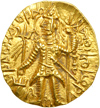 |
Kushan Kingdom. Vasudeva II, c. AD 250-260. Gold Stater (7.84 g). Ruler sacrificing to left. Reverse: Siva standing frontally; behind, bull. Mitchiner 3504v. Lustrous; Choice Extremely Fine.
Estimated Value $750 - 900.
View details and enlarged photos
| Realized
$834 |
Lot 100 |
 |
Kushan Kingdom. Vasudeva I and successors, c. AD 260-300. Gold Stater (8.05 g). Ruler sacrificing to left. Reverse: Siva standing frontally; behind, bull. Rosenfield 231; Mitchiner 3541. Choice Extremely Fine.
Estimated Value $900 - 1,100.
View details and enlarged photos
| Realized
$978 |
Lot 101 |
 |
Kushan Kingdom. Vasudeva I and successors, c. AD 260-300. Gold Stater (7.89 g). Ruler sacrificing to left. Reverse: Siva standing frontally; behind, bull. Rosenfield 233; Mitchiner 3540. Extremely Fine.
Estimated Value $750 - 900.
View details and enlarged photos
| Realized
$748 |
Lot 102 |
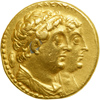 |
Ptolemaic Egypt. Ptolemy II, 285-246 BC. Gold Oktadrachm (or Mnaieion; 27.72 g) minted at Alexandria after 270 BC. Diademed jugate busts right of Ptolemy II and Arsinoê II. Reverse: Diademed jugate busts right of Ptolemy I and Berenike I. Svoronos 603. Choice Very Fine.
This handsome gold coin of Egypt is part of the diverse series of coins which commemorates the Ptolemaic lineage. Four excellent portrayals are noted. Great wealth is felt by hefting this impressive coin type.
Estimated Value $14,000 - 17,000.
View details and enlarged photos
| Unsold |
Lot 103 |
 |
Ptolemaic Egypt. Ptolemy IV, 222-205 BC. Gold Oktadrachm (or Mnaieion; 27.79 g) min. Radiate and diademed bust right of the deified Ptolemy III, holding trident and wearing aegis over shoulder. Reverse: Radiate and filleted cornucopiae. Sv. 1117; SNG Cop 196. Nearly Extremely Fine.
Estimated Value $10,000 - 12,500.
View details and enlarged photos
| Realized
$10,350 |
Lot 104 |
 |
Ptolemaic Egypt. Ptolemy IV, 222-205 BC. Gold Oktadrachm (or Mnaieion; 27.76 g) minted at Alexandria, c. 217 BC. Radiate and diademed bust right of the deified Ptolemy III, holding trident and wearing aegis over shoulder. Reverse: Radiate and filleted cornucopiae. Sv. 1117; SNG Cop 196. Scratch in reverse right field from 2 o'clock to 3 o'clock. Nearly Extremely Fine.
Estimated Value $10,000 - 12,500.
View details and enlarged photos
| Unsold |
Lot 105 |
 |
Ptolemaic Egypt. Ptolemy IV, 222-205 BC. Gold Oktadrachm (or Mnaieion; 27.82 g) minted at Alexandria, c. 217 BC. Radiate and diademed bust right of the deified Ptolemy III, holding trident and wearing aegis over shoulder. Reverse: Radiate and filleted cornucopiae. Sv. 1117; SNG Cop 196. A little over-cleaned, but boldly struck and handsome. Nearly Extremely Fine.
Estimated Value $10,000 - 12,500.
View details and enlarged photos
| Realized
$13,225 |
Lot 106 |
 |
Ptolemaic Egypt. Ptolemy IV, 222-205 BC. Gold Tetradrachm or Half Mnaieion (13.83 g) minted at Alexandria, c. 217 BC. Radiate and diademed bust right of the deified Ptolemy III, holding trident and wearing aegis over shoulder. Reverse: Radiate and filleted cornucopiae. Sv. 1118; BMC 105. Nearly Extremely Fine.
Like so many fractional coins, this denomination is rarer than its larger counterpart. Along with its double, this lot would make an ideal pairing for an advanced collection of either ancient gold or coins of the Ptolemies.
Estimated Value $9,000 - 11,000.
Ex Sale of a Lady (Christie's, 9 October, 1984), lot 302.
View details and enlarged photos
| Realized
$13,225 |
Lot 107 |
 |
Ptolemaic Kingdom. Ptolemy VI and Ptolemy VIII, Kings of Egypt, 180-116 BC. Gold Octodrachm (27.88 g), Alexandria. Issued in the name of Arsinoê II. Veiled head of Arsinoê right, wearing diadem and stephane, with ram's horn at ear; at shoulder and behind head, lotus scepter, and in left field, K. Reverse: Double cornucopiae, bound with fillet; in Greek, name of Arsinoê and title. Svoronos 1498-9; SNG Cop. 321-2; SNG Delepierre 3063 (as head of Cleopatra I); Dewing Coll. 2762. Well centered and struck up, the high relief portrait dignified and elegant for this series. Very lustrous. NGC graded Mint State.
Estimated Value $10,000 - 12,500.
Ex Millennia Sale, Lot 71.
View details and enlarged photos
| Realized
$20,125 |
Lot 108 |
|
Two Silver Tetradrachms of the Ptolemaic Kingdom of Egypt. Ptolemy VI (long chip at lower obverse edge, otherwise Choice VF) and Ptolemy IX with Cleopatra III (Very Fine). Lot of 2 coins.
Estimated Value $175 - 225.
View details
| Realized
$230 |
|
|